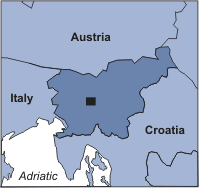The area of Polhograjsko hribovje in central Slovenia was chosen to illustrate the model. Polhograjsko hribovje is a very rugged and dramatic landscape with steep hills and deeply incised valleys. Even today it is mostly covered with forests, with only scattered islands of human presence. My personal experience of moving through it revealed the enormous importance of sound, and very often it was man-made sounds – traffic, church bells – that offered spatial cues for orientation and marked human presence in the landscape.

Figure 1: Location map of the study area of Polhograjsko hribovje in central Slovenia

Figure 2: Polhograjsko hribovje. Shaded topography and location of churches. The area measures 5 by 5km
The work, still at the preliminary stage, represents a first attempt to explore the role of sound in the social construction of late medieval landscapes of Polhograjsko hribovje in central Slovenia. I am interested in specific sounds, namely the soundmarks of bells of the numerous churches dominating, not only visually, the rugged and forested landscape of Polhograjsko hribovje. Most of the churches in the study area were built in the 14th and 15th century AD, during a process of intensive upland colonisation. The results of this process can still be seen today as a pattern of scattered farmsteads and hamlets.
The main idea, which has to be developed further and supported with more arguments, is that the sound of church bells played a major role in the Christianisation of a previously untamed landscape and, ideologically and symbolically, set the stage for the process of upland colonisation.
© Internet Archaeology
URL: http://intarch.ac.uk/journal/issue16/6/41.html
Last updated: Thur Nov 11 2004